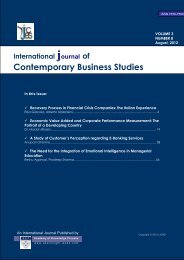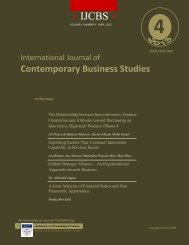Contemporary Business Studies - Academy of Knowledge Process ...
Contemporary Business Studies - Academy of Knowledge Process ...
Contemporary Business Studies - Academy of Knowledge Process ...
Create successful ePaper yourself
Turn your PDF publications into a flip-book with our unique Google optimized e-Paper software.
International Journal <strong>of</strong> <strong>Contemporary</strong> <strong>Business</strong> <strong>Studies</strong>Vol: 4, No: 2. February, 2013 ISSN 2156-7506Available online at http://www.akpinsight.webs.comCONCLUSIONWhen speaking about the ‘fight on terrorism’, Chancellor <strong>of</strong> the Exchequer Mr. Gordon Brown, formerPrime Minister <strong>of</strong> the United Kingdom stated, “What the use <strong>of</strong> fingerprints was to the 19 th century, andDNA analysis was to the 20 th century, so financial information and forensic accounting has come to beone <strong>of</strong> today’s most powerful investigative and intelligence tools available,” (Muehlmann, Burnaby andHowe, 2012). There is no doubt that a “qualified, trained and mature accounting pr<strong>of</strong>essionals, possessingforensic skills, can prove to be a valuable asset to the corporate-sector, and gradually help to improvetheir CG system.” Forensic accounting in India, <strong>of</strong> late, has come “to limelight due to the rapid increase in‘white-collar’ crimes and the belief that our law-enforcement agencies do not have the ‘expertise’ neededor time to uncover frauds.” Forensic accounting, in fact, integrates accounting, auditing, and investigativeskills to conduct an examination into a company’s financial statements. Broad-based knowledge is crucialto the success <strong>of</strong> entry-level FA’s. In 2011, the AICPA conducted a survey to evaluate trends within the‘Forensic and Valuation Services’ practice area. The vast majority <strong>of</strong> participating forensic accountingpr<strong>of</strong>essionals reported “significantly increasing demand for their services in recent years. They als<strong>of</strong>orecast greater demand in the next two to five years accompanied by an uptick in litigation andregulatory enforcement during the same period.” Moreover, DeLoach (2012) characterized forensicaccounting as “somewhat <strong>of</strong> a ‘niche’ because it requires multi-disciplinary expertise that crosses therealms <strong>of</strong> accounting, criminal investigation, regulatory legislation and judicial litigation.” We have seengrowth in all areas <strong>of</strong> forensics, especially in computer forensics, which is being driven by the increasinguse <strong>of</strong> technology and concerns about cyber-security. The FBI and Justice Departments are looking forFA’s because the reach <strong>of</strong> the pr<strong>of</strong>ession has spread to areas such as money laundering and even terrorismcases (Brooks et al., 2005). KPMG, a large accounting firm, believe the market is sufficiently large tosupport an independent unit devoted strictly to ‘forensic’ accounting. All <strong>of</strong> the larger accounting firms,as well as, many medium-sized and boutique firms have recently created forensic accountingdepartments.The recent wave <strong>of</strong> corporate fraudulent financial reporting has prompted global actions for reforms inCG and financial reporting, by governments and accounting and auditing standard-setting bodies in theU.S. and internationally. The enactment <strong>of</strong> Sarbanes-Oxley Act (SOX) <strong>of</strong> 2002 was the U.S.government’s response to the wave <strong>of</strong> fraudulent corporate financial reporting experienced during the1980s and early 2000s, and represented a significant step in regaining investors’ confidence in the globalfinancial reporting process. The Act created new and stricter statutes to avoid a repeat <strong>of</strong> previouscorporate financial disasters. The arrival <strong>of</strong> the SOX, the subsequent formation <strong>of</strong> the Public CompanyAccounting Oversight Board (PCAOB), and the implementation <strong>of</strong> the Statement on Auditing StandardsNo. 99 (SAS 99) has presented the current auditing environment with a new paradigm that makes findingfraud a priority. According to Wells (2011), “SAS 99 is unique because it claims that there is a risk <strong>of</strong>fraud in every business. The new standard describes specific steps that the auditors must follow during anaudit engagement. These steps include pre-audit brainstorming, increased pr<strong>of</strong>essional skepticism,additional inquiries, consideration <strong>of</strong> risk factors, a determination <strong>of</strong> the response to the risk factors, andextensive documentation.” SAS 99 also requires that the audit staff be evaluated to determine if they haveenough fraud expertise.In modern technology-based era, most <strong>of</strong> the criminals behind fraud use sophisticated technology andaccounting tricks to commit complex frauds. This means that a FA needs the state-<strong>of</strong>-the-art facilities touncover fraud (Ozkul and Pamukcu, 2012). Computers are common tools used by the culprits behind“white-collar” crimes. In order to find “the smoking gun,” the FA will need to be able to dig-deep into thecompany’s computer system. To facilitate the preservation, collection, analysis and documentation <strong>of</strong>evidence, FA’s can use specialized s<strong>of</strong>tware and computer hardware. For instance, Deloitte & Touche hasset up a world-wide network <strong>of</strong> computer forensic labs for their FA and technicians. There are many newtechnologies that allow the investigators to recover deleted files, crack encryptions or codes, and extract2013©<strong>Academy</strong> <strong>of</strong> <strong>Knowledge</strong> <strong>Process</strong>77
















